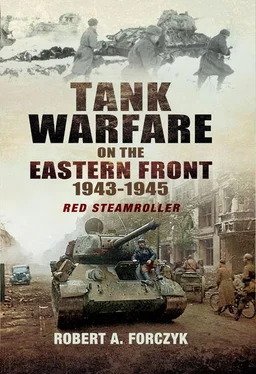Retreats are painful and even worse if the enemy is actively pursuing. Many of the German tanks that were damaged or awaiting repair had to be blown up, including 20 of Fechner’s brand-new Panthers. {175} A total of 80 Panthers were lost in September, mostly due to mechanical defects that forced their crews to abandon them. {176} Discipline in some German units began to slip during the retreat as troops availed themselves of liquor from supply depots that were going to be abandoned. Other troops simply went missing. Von Manstein’s forces had to retreat 150km or more to get behind the Dnepr and then cross at one of six bridges. The German infantry divisions relied on horses and carts to move their artillery and supplies, which meant that they could not outrun fast-moving armour units equipped with T-34s. This discrepancy in tactical mobility meant that most of the German Panzer-Divisionen would have to conduct rear guard actions in order to buy time for the slower-moving formations to retreat to the Dnepr. However, von Manstein also recognized that he needed to get some forces to the main crossing sites over the Dnepr – at Kiev, Kanev, Cherkassy, Kremenchug, Dnepropetrovsk and Zaporozhe – as soon as possible in order to prevent the Soviets from seizing any of these with a coup de main. Thus, von Manstein was on the horns of a dilemma about the best use of his armour during the retreat – to protect his infantry or to protect the crossing sites. Von Manstein decided to deploy all of the III. and XXXXVIII Panzerkorps to conduct a major delay operation at Poltava with four Panzer-Divisionen (3., 6., 7., 11.) and four Panzergrenadier-Divisionen ( Wiking , Das Reich , Totenkopf and Großdeutschland ) in order to give his slower-moving forces more time to withdraw. However, the 19.Panzer-Division was ordered to retreat straight to Kiev and then spread out to defend the far side of the river. Hoth was ordered to retreat toward Kiev, Kanev and Cherkassy, then spread out quickly to defend the various crossing sites. Wöhler’s AOK 8 was to head for Kremenchug, but assist with the delay at Poltava. Von Mackensen’s PzAOK 1 would head for Dnepropetrovsk and Zaporozhe, while Hollidt’s AOK 6 would retreat to Melitopol. As the retreat began, it began to rain heavily, further slowing the Germans down.
The Stavka had been expecting von Manstein to retreat to the Dnepr at any time and once indications of withdrawal were detected by Soviet aerial reconnaissance, Stalin issued orders directly to the fronts for the advance to the Dnepr. Five fronts surged toward the Dnepr with over two million troops and 2,000 tanks. Vatutin would head for Kiev and the Dnepr Knee and was provided Rybalko’s partly-refitted 3 GTA (7 GMC, 9 MC, 6 GTC, 7 GTC, 91 TB) to act as a mobile group ( podvizhnyi grupp ) in the drive toward the Dnepr from the Romny area. Although Rybalko only had about 50 per cent of his authorized tanks and one of his motorized brigades had no trucks, it was still a powerful force with over 300 tanks. Both Katukov’s 1 TA and Rotmistrov’s 5 GTA had been temporarily pulled back to refit after weeks of heavy combat, leaving Rybalko’s half-strength tank army as the only large mechanized formation available for the time being. Konev was ordered to head for Kremenchug, Malinovsky for Dnepropetrovsk and Tolbukhin for Melitopol. While all these fronts received additional reinforcements from the RVGK, ammunition and fuel stockpiles at the front were very low after weeks of heavy combat and this impaired the ability of the Red Army to conduct high-tempo mobile operations for more than a few days. {177} Nor did the Red Army logisticians have the means of moving large amounts of supplies forward, due to shortages of trucks and the damage inflicted upon the rail lines by the retreating Germans. In terms of engineer support, the fronts moving toward the Dnepr had five pontoon bridging brigades and three heavy pontoon regiments, but the problem was that the ‘scorched earth’ tactics used by the Germans made it difficult to push these cumbersome support units forward to where they needed to be and the insufficient amount of fuel available was mostly going to combat units. {178}
Recognizing the difficulty of crossing the Dnepr, the Stavka began preparing several airborne brigades to support an assault crossing of the Dnepr. Vatutin was given operational control over a provisional airborne corps (1st, 3rd and 5th Guards Airborne Brigades) with 10,000 paratroopers and the authority to employ them. On the night of 19–20 September, Rybalko’s 3 GTA began advancing toward the Dnepr, with Podpolkovnik Trofim F. Malik’s 56th Guards Tank Brigade as the advance guard. The Stavka believed that the Germans would have all the major crossing sites well defended (a false assumption, as it turned out) so Rybalko was ordered to head for the so-called ‘Dnepr Knee,’ a great bend in the river south of Kiev and near the Kanev crossing site. Soviet partisans had reported that there were no German forces in this area and the Stavka hoped that Rybalko could ‘bounce’ this undefended section of the Dnepr before the Germans arrived.
Nehring’s XXIV Panzerkorps retreated toward Kanev with the 10.Panzergrenadier-Division, Sturmgeschütz-Abteilung 239 and elements of three battered infantry divisions. Unknown to him, Rybalko’s armour was coming up fast behind him, but Nehring did not opt to conduct any delaying actions. Oberst Hans Källner’s 19.Panzer-Division crossed the Dnepr at Kiev on 20 September, the first of von Manstein’s armoured units to regain the western bank. Even before Källner’s division was assembled in Kiev, he was ordered to dispatch his reconnaissance battalion to the Dnepr Bend to look for any signs of Soviet crossing activity. Meanwhile, the III. and XXXXVIII Panzerkorps fought a bitter – and futile – delaying action at Poltava on 20–22 September against Konev’s forces, before abandoning the city on 23 September.
Rybalko’s armour advanced rapidly and covered 165km in a single day; by the evening of 21 September his lead units were approaching the Dnepr Bend. Then his tanks ran out of fuel, just short of the river. General-major Mitrofan I. Zin’kovich, commander of the 6 TC, frantically radioed Rotmistrov and requested an emergency fuel resupply of 20–30 tons of diesel. {179} Some of the Soviet infantry travelling as desant troops with Malik’s brigade continued on foot to the river and the 95-man Submachinegun Company used a few small boats to cross near Grigorovka, north of Kanev, before dawn on 22 September. This tiny force was soon reinforced to battalion-size. Shortly thereafter, small numbers of infantry from General-polkovnik Kirill S. Moskalenko’s 40th Army’s 309th Rifle Division also crossed the Dnepr at Rzhyshchiv, 25km to the west. These initially non-contiguous lodgements of 3 GTA and 40 A were thereafter collectively known as the Bukrin bridgehead. The Bukrin area was heavily wooded and isolated. There were no German troops in the area, but Rittmeister Helmut von Moltke’s Panzer-Aufklärungs-Abteilung 19 had been assigned to conduct screening operations in this sector and was already en route. Rybalko’s troops were the first to cross the Dnepr, but unless he could quickly get tanks and artillery across, the Germans would move against the tiny Bukrin bridgehead and crush it. At Grigorovka the Dnepr was 600–800 meters wide and 8 metres deep, so tanks could not cross without pontoon bridges or ferries, which would take days to prepare.
It took the Germans about 24 hours to realize that the Soviets had already gained a toehold across the Dnepr at Bukrin, but once this was confirmed by von Moltke’s reconnaissance troops on the afternoon of 23 September, Källner was ordered to move a reinforced Kampfgruppe (two Panzergrenadier battalions, one artillery battalion, one tank company and a few Panzerjägers and pioniers) from his division to conduct a counter-attack. Nehring’s XXIV Panzerkorps, still crossing at Kanev, was also ordered to send a Kampfgruppe from 57.Infanterie-Division to Kanev. On the night of 23–24 September, Rybalko and Moskalenko conducted a ‘mass crossing’ of the Dnepr with thousands of troops moving to the opposite shore on rafts and fishing boats or simply swimming. By 24 September, Moskalenko and Rybalko had enough troops on the west side of the Dnepr to expand their bridgehead to a depth of 3–4km and pushed back von Moltke’s screening troops. General-major Zin’kovich personally decided to cross into the bridgehead with some of his infantry (an odd choice for a tank corps commander), but he was mortally wounded by a Luftwaffe air attack that struck the crossing site. {180}
Читать дальше








![John Stieber - Against the Odds - Survival on the Russian Front 1944-1945 [2nd Edition]](/books/405234/john-stieber-against-the-odds-survival-on-the-russian-front-1944-1945-2nd-edition-thumb.webp)



